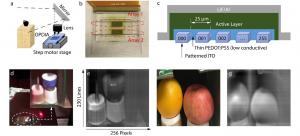New organic infrared photodetectors: a breakthrough in imaging technology
USA, May 9, 2024 /EINPresswire.com/ -- In a major breakthrough for the field of artificial intelligence (AI), researchers have developed a new class of organic semiconductors with narrow bandgaps that greatly improve the performance of infrared (IR) photodetectors and image arrays. This study shows that these organic materials can match the detectivity and efficiency of traditional inorganic semiconductors, paving the way for high-resolution, cost-effective imaging systems.
The demand for high pixel-count, low-cost focal-plane arrays in the near-infrared (NIR) and short-wavelength infrared (SWIR) spectra has surged due to their potential applications in AI-driven technologies such as 3D face-identification, augmented/virtual reality, robotics, and autonomous vehicles. Traditional SWIR photodiodes rely on crystalline germanium (Ge) or indium gallium arsenide (InGaAs), which have limitations including high dark current and complex fabrication processes. The advent of organic semiconductors offers a promising alternative, with the potential for easier fabrication and tunable optical properties.
Researchers from South China University of Technology have created a groundbreaking class of organic semiconductor-based infrared photodetectors poised to transform imaging technology. A study (DOI: 10.1007/s10118-023-2973-8) published in the Chinese Journal of Polymer Science reveals that these organic photodiodes can function across a wide range of wavelengths—from near-ultraviolet to short-wavelength infrared—outperforming traditional inorganic detectors.
Utilizing polymer semiconductors with narrow bandgaps, the team created thin-film photodiodes capable of detecting a broad range of infrared wavelengths. This new technology achieves performance levels that rival traditional inorganic photodetectors, such as those made from indium gallium arsenide (InGaAs), but at a fraction of the cost. The researchers combined strategies of a larger heteroatom, a regio-regular backbone and an extended branching position on side chains to develop polymer semiconductors with a spectral response spanning from near-ultraviolet to short-wavelength infrared. The resulting devices exhibited impressive specific detectivity, reaching 5.55×10¹² Jones at 1.15 μm, competitive with InGaAs-based detectors. These organic photodetectors were assembled into high-pixel-density image arrays, with the unique feature of not requiring pixel-level patterning in the sensing layer. This approach simplifies the manufacturing process and significantly reduces costs.
Prof. Fei Huang, one of the lead researchers, emphasized the significance of this breakthrough: "Our development of organic photodetectors marks a pivotal step toward cost-effective, high-performance infrared imaging technology. These devices offer a flexible and scalable alternative to traditional inorganic photodiodes, with potential applications ranging from industrial robotics to medical diagnostics."
These new organic photodetectors could significantly impact several industries. They offer a low-cost alternative for imaging systems used in security and surveillance. Additionally, the organic-based technology could lead to more affordable and accessible medical imaging devices, allowing for broader adoption in healthcare settings. The flexibility and scalability of these devices also open doors to innovative applications in artificial intelligence and robotics.
DOI
10.1007/s10118-023-2973-8
Original Source URL
https://doi.org/10.1007/s10118-023-2973-8
Funding information
This work was financially supported by the National Natural Science Foundation of China (Nos. U21A6002 and 51933003) and the Basic and Applied Basic Research Major Program of Guangdong Province (No. 2019B030302007).
Lucy Wang
BioDesign Research
email us here
Legal Disclaimer:
EIN Presswire provides this news content "as is" without warranty of any kind. We do not accept any responsibility or liability for the accuracy, content, images, videos, licenses, completeness, legality, or reliability of the information contained in this article. If you have any complaints or copyright issues related to this article, kindly contact the author above.

